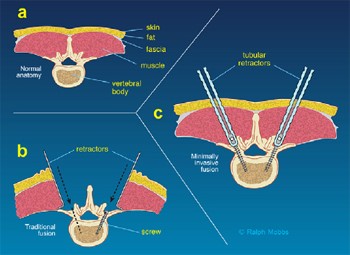Minimally Invasive Spine Surgery
The Minimally Invasive Surgery of the Spine, treats the whole spectrum of spinal conditions with modern, advanced techniques. They are implemented with small incisions of the skin (~1cm) and the use of micro-endoscopic techniques under visual magnification. This prevents bleeding and minimizes the destruction of adjoining tissues, achieving a great surgical result.
It includes techniques such as:
- • Epidural, intrathecal infusion (Block), the exclusion of the posterior joints (Facet Joints) and the infusions in the sympathetic nerves. The aforementioned are techniques that can treat chronic or acute spinal or leg pain that the nerve roots are causing.
- • The thermal or chemical reduction of the nucleus of the intervertebral disc (discoplasty).
- • Endoscopic spinal procedures
Other chapters of the spinal pathology includes:
The wedge vertebral fracture of the spine, which are caused by some injury or an automatic mechanism due to strain of the spinal column and some related pathology, such as osteoporosis or other conditions, are treated by the kyphoplasty method. Kyphoplasty is a method of internal reduction and stabilisation of the fractures percutaneously.
Also when it has to be done the stabilisation/fusion of the spine, in cases that is necessary, we use minimally invasive percutaneous techniques such as:
• Tlif,
• Xlif,
• Plif,
• Axialif
• OLIF
• Endoscopic assisted Lumbar Iinterbody Fusion
And also for pedicle screws and/or artificial discs where is necessary to preserve motion.
In the same minimally invasive way we treat the children or adolescent spinal deformities and the revision surgeries caused by Failed Back Surgery Syndrome.
In cases we need to preserve the spinal motion especially in the cervical spine we use artificial discs (ACDR) that we use instead of fusion (ACDF) in between the vertebrae in the disc space
The above procedures can be performed under intraoperative fluoroscopy imaging, O-arm navigation or Robotic guidance and many of them under local anaesthesia. Thus, the patient usually leaves the hospital the same day, a few hours after the surgery, returning to his usual activities as soon as possible.


Laminoplasty
A laminoplasty is a surgical procedure that creates more space for the spinal cord and nerve roots to relieve abnormal pressure on the spinal cord. Laminoplasty is a motion preserving surgery, meaning that no fusion is performed, and motion is not changed.
Laminoplasty is performed to treat spinal stenosis in the neck or low back and may also act as a method to access underlying spinal disease such as a spinal tumor or syringomyelia, a spinal cord cyst. It opens up the space within the spinal canal by creating a hinge on the lamina. Metal hardware bridges the gap in the opened section of the spine.
A laminoplasty may be performed to treat the following conditions:
• Spinal stenosis
• Spinal tumors
• Syringomyelia, a spinal cord cyst
During the surgery the patient lies face down on a special surgical bed. The procedure is performed through a small incision on the back of the spine. This allows the vertebrae to open like a door, creating more space in the spinal canal. This immediately relieves pressure from the spinal cord and nerve roots.
Foraminoplasty
Foraminoplasty is used to treat people with long-lasting back and leg pain. This type of pain can be caused by problems with the discs that act as cushions between the bones of the spine (which are called vertebrae). The discs have a tough outer cover, with a jelly-like material inside it. If the outer cover is damaged or weakened, the material inside can stretch the cover outwards, distorting the shape of the disc. This is a slipped disc, and the medical term for it is a prolapsed intervertebral disc. If the distorted disc presses on a nerve or the spinal cord it can cause pain. The nerves that go to the legs leave the spinal cord in the lower back and pass through an opening in the vertebra called a foramen. Most people recover from this in time without an operation. But if the pain remains severe for a long time, or there are problems with the nerves, the person may be offered an operation.
Foraminoplasty is a new type of operation used to treat back and leg pain. A thin flexible telescope (called an endoscope) is inserted through a small cut in the patient’s back, and guided to the affected vertebra. Different endoscopic instruments are used to remove the parts of the disc that are narrowing the foramen or even open the roof of the foramen. This reduces the pressure on the nerve, which should relieve the pain.